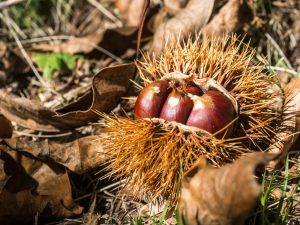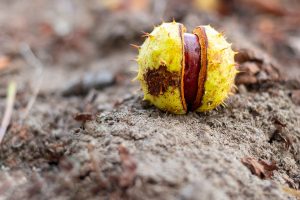Todays seasonal spotlight is one very close to my heart.
When I was a child, my parents had three huge chestnuts that towered over their garden. As soon as the shells ripened and fell, I would spend autumn weekends in the garden, collecting the nuts to roast on the fire.
I would use my wellies to slowly peel open the shells- holding one side still under my sole and using the other foot to peel back the shell- a move that I still have down to an art. My pockets were constantly filled with the glistening brown nuts, and for the few months they were in season, there was always a full bowl on the mantle.
I can vividly remember perching beside the roaring open fire with my Pa, roasting chestnuts on the coal shovel. He would pierce the shells with his trusty Opinel pocket knife- you’ll still find it tucked into the back pocket of his jeans.
These memories come back to me year on year- when the streets are littered with the hedgehog-spiked shells, or I smell the popcorn-like smell of roasting chestnuts wafting on the air from a street trader. A single bite will take me back in time and I’ll be transported back to the warm embrace of an open fire and the cosy company of my Pa.
Sweet Chestnuts are a true forager's treasure. They’re easily identifiable (their hedgehog-like spines are hard to mistake), easy to cook and oh-so-delicious. They’re the perfect forage to hunt for with the kids this autumn!
A pair of sturdy shoes
A pair of gloves
Big Pockets or a bag/basket
Large, spiky balls. They are covered in a huge number of sharp, skinny spines- just like a hedgehog. Inside, you’ll find around three teardrop-shaped nuts, a dark gleaming chestnut in colour. They often have little spiky ‘tassels’ at the top.

You’ll often find them littering the floor between October and December. You want to look for shells that are brown all over- you’re most likely to find these in brown spiky pods. You’ll find the green ‘pods contain nuts that are still a little white. You can ripen these at home- simply pop them in a brown paper bag in a warm, dry place (like an airing cupboard) for a few days, shaking daily to aerate.
If the nuts have been on the ground for too long, they might have fallen prey to weevils. Be sure to check for little holes in the shells as they’re the tell-tale sign that some little grub has got to the nut before you!
Horse chestnuts are a relative of the sweet chestnut. Their nuts are poisonous so watch out! Luckily, there are several easy to spot distinguishers that will help you discern friend from foe.
Horse chestnut shells look less like a hedgehog and more like a mace and chain. The spikes are small are further apart- made from the shell casing itself. They look a little like a spiky tortoise shell.

A horse chestnuts nuts are known as conkers. You might have seen them in the playground. These nuts are round and sit one to a pod. Unlike the sweet chestnut, they are round in shape (not tear-drop) and a little larger. They don’t have points or tassels.

A sharp knife
Ovenproof gloves
An open fire or oven
A baking tray, small frying pan, or coal shovel.
First, you’ll need to pick your chestnuts. Peel back the spiky outer shells with your gloves and pick out the shining nuts. Ideally, you want them to be a glossy brown all over. Take a look at the foraging section above or more info on picking your own.
Before cooking your chestnuts, you’ll need to cut through the outer shell with a sharp knife. Make a single slit or cross across the flat side of the nutshell. This opening will allow the steam to escape, and make sure your nuts don’t explode!
If you have an open fire or a bonfire, you can cook them on the flames or embers. We’ve always used the coal shovel, but you can use a metal spoon or a mall frying pan if you don’t have one.
Place the scored nuts on your roasting implement, scored side up, and place them in a bed of embers, or any warm part of the fire where they won’t be licked by the flames. Roast them for between 12-20 minutes, jiggling occasionally.
You’ll know they’re ready when the shells begin to peel back the and the insides are a warm golden or soft brown. They should be warm and soft all the way through, with a sweet nutty, biscuity taste.
Place your nuts, slit side up on a baking tray and pop in a preheated oven (at around 180C) for 15-20 minutes.
Just like with the fire method you’ll know they’re ready when the shells begin to peel back ad expose a warm golden nut. They should be warm and soft all the way through, with a nutty, biscuity taste.
Fascinated by Foraging? Join our like-minded community in the Kitchen Table Revolution. For less than the price of a tea and cake per week, we'll teach you to craft your own culinary delights with the finest seasonal and foraged ingredients. Click here to find out more!
Got any questions? Get in touch! Head to our socials (either Facebook or Instagram) to pop a message on our wall or send us a DM.
Want more fantastical foraging content? Sign up to our email newsletter! We’ll send you mouthwatering recipes, fascinating folklore and fantastic foraging tips.